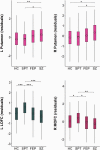Orbitofrontal-Striatal Structural Alterations Linked to Negative Symptoms at Different Stages of the Schizophrenia Spectrum
- PMID: 33257954
- PMCID: PMC8084448
- DOI: 10.1093/schbul/sbaa169
Orbitofrontal-Striatal Structural Alterations Linked to Negative Symptoms at Different Stages of the Schizophrenia Spectrum
Abstract
Negative symptoms such as anhedonia and apathy are among the most debilitating manifestations of schizophrenia (SZ). Imaging studies have linked these symptoms to morphometric abnormalities in 2 brain regions implicated in reward and motivation: the orbitofrontal cortex (OFC) and striatum. Higher negative symptoms are generally associated with reduced OFC thickness, while higher apathy specifically maps to reduced striatal volume. However, it remains unclear whether these tissue losses are a consequence of chronic illness and its treatment or an underlying phenotypic trait. Here, we use multicentre magnetic resonance imaging data to investigate orbitofrontal-striatal abnormalities across the SZ spectrum from healthy populations with high schizotypy to unmedicated and medicated first-episode psychosis (FEP), and patients with chronic SZ. Putamen, caudate, accumbens volume, and OFC thickness were estimated from T1-weighted images acquired in all 3 diagnostic groups and controls from 4 sites (n = 337). Results were first established in 1 discovery dataset and replicated in 3 independent samples. There was a negative correlation between apathy and putamen/accumbens volume only in healthy individuals with schizotypy; however, medicated patients exhibited larger putamen volume, which appears to be a consequence of antipsychotic medications. The negative association between reduced OFC thickness and total negative symptoms also appeared to vary along the SZ spectrum, being significant only in FEP patients. In schizotypy, there was increased OFC thickness relative to controls. Our findings suggest that negative symptoms are associated with a temporal continuum of orbitofrontal-striatal abnormalities that may predate the occurrence of SZ. Thicker OFC in schizotypy may represent either compensatory or pathological mechanisms prior to the disease onset.
Keywords: apathy; cortical thickness; first-episode psychosis; negative symptoms; orbitofrontal cortex; schizophrenia spectrum; schizotypy; striatum; structural MRI.
© The Author(s) 2020. Published by Oxford University Press on behalf of the Maryland Psychiatric Research Center.All rights reserved. For permissions, please email: journals.permissions@oup.com.
Figures


Similar articles
-
Ventral Striatal Dysfunction and Symptom Expression in Individuals With Schizotypal Personality Traits and Early Psychosis.Schizophr Bull. 2018 Jan 13;44(1):147-157. doi: 10.1093/schbul/sbw142. Schizophr Bull. 2018. PMID: 27798223 Free PMC article.
-
Increased Striatal and Reduced Prefrontal Cerebral Blood Flow in Clinical High Risk for Psychosis.Schizophr Bull. 2018 Jan 13;44(1):182-192. doi: 10.1093/schbul/sbx070. Schizophr Bull. 2018. PMID: 28575528 Free PMC article.
-
Decreased number of orbital sulci in schizophrenia spectrum disorders.Psychiatry Res Neuroimaging. 2016 Apr 30;250:29-32. doi: 10.1016/j.pscychresns.2016.03.005. Epub 2016 Mar 19. Psychiatry Res Neuroimaging. 2016. PMID: 27017422
-
Functional connectivity of the striatum in psychosis: Meta-analysis of functional magnetic resonance imaging studies and replication on an independent sample.Neurosci Biobehav Rev. 2025 Jul;174:106179. doi: 10.1016/j.neubiorev.2025.106179. Epub 2025 Apr 25. Neurosci Biobehav Rev. 2025. PMID: 40288705 Review.
-
[Brain imaging of first-episode psychosis].Encephale. 2013 Sep;39 Suppl 2:S93-8. doi: 10.1016/S0013-7006(13)70102-7. Encephale. 2013. PMID: 24084428 Review. French.
Cited by
-
Neurostructural subgroup in 4291 individuals with schizophrenia identified using the subtype and stage inference algorithm.Nat Commun. 2024 Jul 17;15(1):5996. doi: 10.1038/s41467-024-50267-3. Nat Commun. 2024. PMID: 39013848 Free PMC article.
-
Comparison of Negative Symptom Network Structures Between Patients With Early and Chronic Schizophrenia: A Network and Exploratory Graph Analysis.Schizophr Bull. 2025 May 8;51(3):672-683. doi: 10.1093/schbul/sbae135. Schizophr Bull. 2025. PMID: 39093707 Free PMC article.
-
A neuromarker for deficit syndrome in schizophrenia from a combination of structural and functional magnetic resonance imaging.CNS Neurosci Ther. 2023 Dec;29(12):3774-3785. doi: 10.1111/cns.14297. Epub 2023 Jun 8. CNS Neurosci Ther. 2023. PMID: 37288482 Free PMC article.
-
Negative symptoms in First-Episode Schizophrenia related to morphometric alterations in orbitofrontal and superior temporal cortex: the OPTiMiSE study.Psychol Med. 2023 Jun;53(8):3471-3479. doi: 10.1017/S0033291722000010. Epub 2022 Feb 24. Psychol Med. 2023. PMID: 35197142 Free PMC article.
-
A Hidden Mark of a Troubled Past: Neuroimaging and Transcriptomic Analyses Reveal Interactive Effects of Maternal Immune Activation and Adolescent THC Exposure Suggestive of Increased Neuropsychiatric Risk.Biol Psychiatry Glob Open Sci. 2025 Jan 23;5(3):100452. doi: 10.1016/j.bpsgos.2025.100452. eCollection 2025 May. Biol Psychiatry Glob Open Sci. 2025. PMID: 40115746 Free PMC article.
References
-
- Galderisi S, Mucci A, Buchanan RW, Arango C. Negative symptoms of schizophrenia: new developments and unanswered research questions. Lancet Psychiatry. 2018;5(8):664–677. - PubMed
-
- Bègue I, Kaiser S, Kirschner M. Pathophysiology of negative symptom dimensions of schizophrenia – current developments and implications for treatment. Neurosci Biobehav Rev. 2020;116:74–88. - PubMed
Publication types
MeSH terms
LinkOut - more resources
Full Text Sources
Medical

